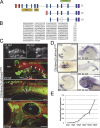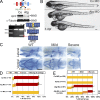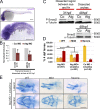Rbms3 functions in craniofacial development by posttranscriptionally modulating TGF-β signaling
- PMID: 23091072
- PMCID: PMC3483135
- DOI: 10.1083/jcb.201204138
Rbms3 functions in craniofacial development by posttranscriptionally modulating TGF-β signaling
Abstract
Cranial neural crest cells form much of the facial skeleton, and abnormalities in their development lead to severe birth defects. In a novel zebrafish protein trap screen, we identified an RNA-binding protein, Rbms3, that is transiently expressed in the cytoplasm of condensing neural crest cells within the pharyngeal arches. Morphants for rbms3 displayed reduced proliferation of prechondrogenic crest and significantly altered expression for chondrogenic/osteogenic lineage markers. This phenotype strongly resembles cartilage/crest defects observed in Tgf-βr2:Wnt1-Cre mutants, which suggests a possible link with TGF-β signaling. Consistent with this are the findings that: (a) Rbms3 stabilized a reporter transcript with smad2 3' untranslated region, (b) RNA immunoprecipitation with full-length Rbms3 showed enrichment for smad2/3, and (c) pSmad2 levels were reduced in rbms3 morphants. Overall, these results suggest that Rbms3 posttranscriptionally regulates one of the major pathways that promotes chondrogenesis, the transforming growth factor β receptor (TGF-βr) pathway.
Figures









References
-
- Akiyama H., Chaboissier M.-C., Martin J.F., Schedl A., de Crombrugghe B. 2002. The transcription factor Sox9 has essential roles in successive steps of the chondrocyte differentiation pathway and is required for expression of Sox5 and Sox6. Genes Dev. 16:2813–2828 10.1101/gad.1017802 - DOI - PMC - PubMed
-
- Alexander C., Zuniga E., Blitz I.L., Wada N., Le Pabic P., Javidan Y., Zhang T., Cho K.W., Crump J.G., Schilling T.F. 2011. Combinatorial roles for BMPs and Endothelin 1 in patterning the dorsal-ventral axis of the craniofacial skeleton. Development. 138:5135–5146 10.1242/dev.067801 - DOI - PMC - PubMed
Publication types
MeSH terms
Substances
Grants and funding
LinkOut - more resources
Full Text Sources
Other Literature Sources
Medical
Molecular Biology Databases

